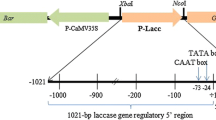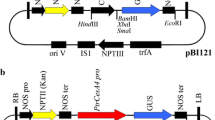Abstract
We tested the efficiency and optimized the conditions for controlled alcohol-inducible transgene expression in Populus using gus as a reporter gene. Specificity of induction, efficiency in different organs, effect of three chemical inducers, and induction methods were tested using up to 10 independent transgenic events generated in two different Populus genotypes. The optimal inducer concentration and the duration of induction period were determined in dose–response and in time–course experiments. Under in vitro conditions, β-glucuronidase (GUS) induction was efficient both in the aerial parts and in the roots of regenerated plantlets. Among the chemical inducers tested, ethanol was the most effective activator with no apparent phytotoxicity when concentrations were at or below 2%. After 5 days of treatment, fluorometrically-determined the GUS activity could be detected when inducing with ethanol at concentrations as low as 0.5%. Prolonged induction by ethanol vapors significantly increased the GUS activity in leaves from both the tissue culture plants and greenhouse-grown plants.







Similar content being viewed by others
Abbreviations
- Ac:
-
Acetaldehyde
- 2-B:
-
2-Butanone
- BAP:
-
6-Benzylaminopurine
- CaMV:
-
Cauliflower mosaic virus
- CIM:
-
Callus-induction medium
- dpi:
-
Days post-induction
- IBA:
-
Indole-3-butyric acid
- IM:
-
Agrobacterium-induction medium
- LB:
-
Luria-Bertani medium
- MS:
-
Murashige and Skoog medium
- RCF:
-
Relative centrifugal force
- SIM:
-
Shoot-induction medium
- TDZ:
-
Thidiazuron
- uidA :
-
β-Glucuronidase, gus reporter gene
- X-Gluc:
-
5-Bromo-4-chloro-3-indolyl-β-d-glucuronic acid
References
Bradford M (1976) A rapid and sensitive method for the quantitation of microgram quantities of protein utilizing the principle of protein dye-binding. Anal Biochem 72:248–254
Brunner AM, Busov VB, Strauss SH (2004) Poplar genome sequence: functional genomics in an ecologically dominant plant species. Trends Plant Sci 9:49–56
Busov VB, Brunner AM, Meilan R, Filichkin S, Ganio L, Gandhi S, Strauss SH (2005) Genetic transformation: a powerful tool for dissection of adaptive traits in trees. New Phytol 167:9–18
Caddick MX, Greenland AJ, Jepson I, Krause KP, Qu N, Riddell KV, Salter MG, Schuch W, Sonnewald U, Tomsett AB (1998) An ethanol inducible gene switch for plants used to manipulate carbon metabolism. Nat Biotechnol 16:177–180
Chen S, Hofius D, Sonnewald U, Bornke F (2003) Temporal and spatial control of gene silencing in transgenic plants by inducible expression of double-stranded RNA. Plant J 36:731–740
Deveaux Y, Peaucelle A, Roberts GR, Coen E, Simon R, Mizukami Y, Traas J, Murray JAH, Doonan JH, Laufs P (2003) The ethanol switch: a tool for tissue-specific gene induction during plant development. Plant J 36:918–930
Flipphi M, Mathieu M, Cirpus I, Panozzo C, Felenbok B (2001) Regulation of the aldehyde dehydrogenase gene (alda) and its role in the control of the coinducer level necessary for induction of the ethanol utilization pathway in Aspergillus nidulans. J Biol Chem 276:6950–6958
Franck A, Guilley H, Jonard G, Richards K, Hirth L (1980) Nucleotide sequence of cauliflower mosaic virus DNA. Cell 21:285–294
Garoosi GA, Salter MG, Caddick MX, Tomsett AB (2005) Characterization of the ethanol-inducible alc gene expression system in tomato. J Exp Bot 56:1635–1642
Grandjean O, Vernoux T, Laufs P, Belcram K, Mizukami Y, Traas J (2004) In vivo analysis of cell division, cell growth, and differentiation at the shoot apical meristem in Arabidopsis. Plant Cell 16:74–87
Han K-H, Meilan R, Ma C, Strauss SH (2000) An Agrobacterium tumefaciens transformation protocol effective on a variety of cottonwood hybrids (genus Populus). Plant Cell Rep 19:315–320
Holstein M, De Wacek D, Depicker A, Messers E, van Montagu M, Schell J (1978) Transfection and transformation of Agrobacterium tumefaciens. Mol Gen Genet 163:181–187
Junker BH, Chu C, Sonnewald U, Willmitzer L, Fernie AR (2003) In plants the alc gene expression system responds more rapidly following induction with acetaldehyde than with ethanol. FEBS Lett 535:136–140
Koncz C, Schell J (1986) The promoter of TL-DNA gene 5 controls the tissue-specific expression of chimaeric genes carried by a novel type of Agrobacterium binary vector. Mol Gen Genet 204:383–396
Kulmburg P, Judewicz N, Mathieu M, Lenouvel F, Sequeval D, Felenbok B (1992) Specific binding sites for the activator protein, ALCR, in the alcA promoter of the ethanol regulon of Aspergillus nidulans. J Biol Chem 267:21146–21153
Lo C, Wang N, Lam E (2005) Inducible double-stranded RNA expression activates reversible transcript turnover and stable translational suppression of a target gene in transgenic tobacco. FEBS Lett 579:1498–1502
Maizel A, Weigel D (2004) Temporally and spatially controlled induction of gene expression in Arabidopsis thaliana. Plant J 38:164–171
Mathieu M, Fillinger S, Felenbok B (2000) In vivo studies of upstream regulatory cis-acting elements of the alcR gene encoding the transactivator of the ethanol regulon in Aspergillus nidulans. Mol Microbiol 36:123–131
Murashige T, Skoog F (1962) A revised medium for rapid growth and bioassays with tobacco tissue culture. Physiol Plant 15:473–497
Padidam M (2003) Chemically regulated gene expression in plants. Curr Opin Plant Biol 6:169–177
Roslan HA, Salter MG, Wood CD, White MRH, Croft KP, Robson F, Coupland G, Doonan J, Laufs P, Tomsett AB, Caddick MX (2001) Characterization of the ethanol-inducible alc gene-expression system in Arabidopsis thaliana. Plant J 28:225–235
Salter MG, Paine JA, Riddell KV, Jepson I, Greenland AJ, Caddick MX, Tomsett AB (1998) Characterisation of the ethanol-inducible alc gene expression system for transgenic plants. Plant J 16:127–132
Schaarschmidt S, Qu N, Strack D, Sonnewald U, Hause B (2004) Local induction of the alc gene switch in transgenic tobacco plants by acetaldehyde. Plant Cell Physiol 45:1566–1577
Strauss SH, Martin FM (2004) Poplar genomics comes of age. New Phytol 164:1–4
Sweetman JP, Chu C, Qu N, Greenland AJ, Sonnewald U, Jepson I (2002) Ethanol vapor is an efficient inducer of the alc gene expression system in model and crop plant species. Plant Physiol 129:943–948
Weigel D, Glazebrook J (2002) Arabidopsis: A laboratory manual. Cold Spring Harbor Laboratory Press,Cold Spring Harbor, NY
Wu L, Joshi CP, Chiang VL (2000) A xylem-specific cellulose synthase gene from aspen (Populus tremuloides) is responsive to mechanical stress. Plant J 22:495–502
Acknowledgements
We thank Syngenta Biotechnology, Inc. for providing pJH0143, and Dr. Renee Arias for the critical discussions during manuscript preparation. This work was supported in part by grants from the Office of Science (BER), U.S. Department of Energy, grant no. DE-4000023558 “Genome-enabled discovery of carbon sequestration genes in poplar”), the National Science Foundation Industry/University Cooperative Research Centers (award no. 9980423), and by members of the Tree Biosafety and Genomics Research Cooperative based at Oregon State University (http://wwwdata.forestry.oregonstate.edu/tgbb/).
Author information
Authors and Affiliations
Corresponding author
Additional information
Communicated by: D.A. Somers
Electronic supplementary material
Rights and permissions
About this article
Cite this article
Filichkin, S.A., Meilan, R., Busov, V.B. et al. Alcohol-inducible gene expression in transgenic Populus . Plant Cell Rep 25, 660–667 (2006). https://doi.org/10.1007/s00299-005-0112-3
Received:
Revised:
Accepted:
Published:
Issue Date:
DOI: https://doi.org/10.1007/s00299-005-0112-3




